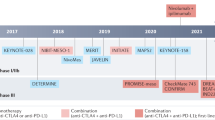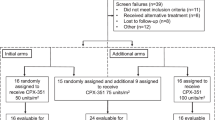Abstract
Twenty-three patients with pleural mesothelioma stage I-IIA were entered in a study of continuous daily intrapleural infusion of interleukin 2 (IL-2) for 14 days, repeated every 4 weeks. IL-2 was administered according to a groupwise dose escalation schedule (group A, 3 x 10(4); group B, 3 x 10(5); group C, 3 x 10(6); group D, 6 x 10(6); group E, 18 x 10(6); and group F, 36 x 10(6) IU day-1). Each group consisted of at least three patients. Intrapleural administration of IL-2 was associated with acceptable toxicity. All patients were treated on an outpatient basis except for the patients at dose levels E and F. Dose-limiting toxicity was observed at level F, 36 x 10(6) IU daily, and consisted of catheter infection, fever and flu-like symptoms. Intrapleural IL-2 levels were high (> 20,000 IU ml-1) at levels E and F, while serum levels in most patients were not or barely detectable (< 3-30 IU ml-1). Intrapleural IL-2 levels were up to 6000-fold higher than systemic levels. Intrapleural tumour necrosis factor alpha (TNF-alpha) levels varied greatly and did not correlate with IL-2 dosage. Intrapleural mononuclear cells (MNCs) displayed IL-2-induced lymphokine-activated killer (LAK) activity in all patients. Two patients were not evaluable for response owing to catheter-related problems which precluded the delivery of IL-2. Partial response (PR) occurred in 4 of 21 evaluable patients (19%; 95% confidence interval 5-42%) with a median time to progression of 12 months (range 5-37). Stable disease (SD) occurred in seven patients with a median time to progression of 5 months (range 2-7). There were no complete responses (CRs). The median overall survival was 15.6 months (range 3.0-43). No relationship between the dose of IL-2 and response rate was observed. We conclude that IL-2 given intrapleurally is accompanied with acceptable toxicity and has anti-tumour activity against mesothelioma. In view of the refractory nature of the disease IL-2 may be a treatment option for mesothelioma. A formal phase II study is warranted. Based on the observed toxicity, the lack of dose-response relationship and the immunomodulatory effects seen at relatively low-dose IL-2, the recommended dose for a phase II study is 3 x 10(6) IU day-1 using the present treatment schedule.
This is a preview of subscription content, access via your institution
Access options
Subscribe to this journal
Receive 24 print issues and online access
$259.00 per year
only $10.79 per issue
Buy this article
- Purchase on Springer Link
- Instant access to full article PDF
Prices may be subject to local taxes which are calculated during checkout
Similar content being viewed by others
Author information
Authors and Affiliations
Rights and permissions
About this article
Cite this article
Goey, S., Eggermont, A., Punt, C. et al. Intrapleural administration of interleukin 2 in pleural mesothelioma: a phase I-II study. Br J Cancer 72, 1283–1288 (1995). https://doi.org/10.1038/bjc.1995.501
Issue Date:
DOI: https://doi.org/10.1038/bjc.1995.501
This article is cited by
-
Intrapleural nano-immunotherapy promotes innate and adaptive immune responses to enhance anti-PD-L1 therapy for malignant pleural effusion
Nature Nanotechnology (2022)
-
Low-Frequency Sonophoresis of Chinese Medicine Formula Improves Efficacy of Malignant Pleural Effusion Treatment
Chinese Journal of Integrative Medicine (2020)
-
Treatment of malignant pleural effusions: the case for localized immunotherapy
Journal for ImmunoTherapy of Cancer (2019)
-
Local and Systemic Therapies for Malignant Pleural Mesothelioma
Current Treatment Options in Oncology (2014)
-
Immune responses and immunotherapeutic interventions in malignant pleural mesothelioma
Cancer Immunology, Immunotherapy (2011)



